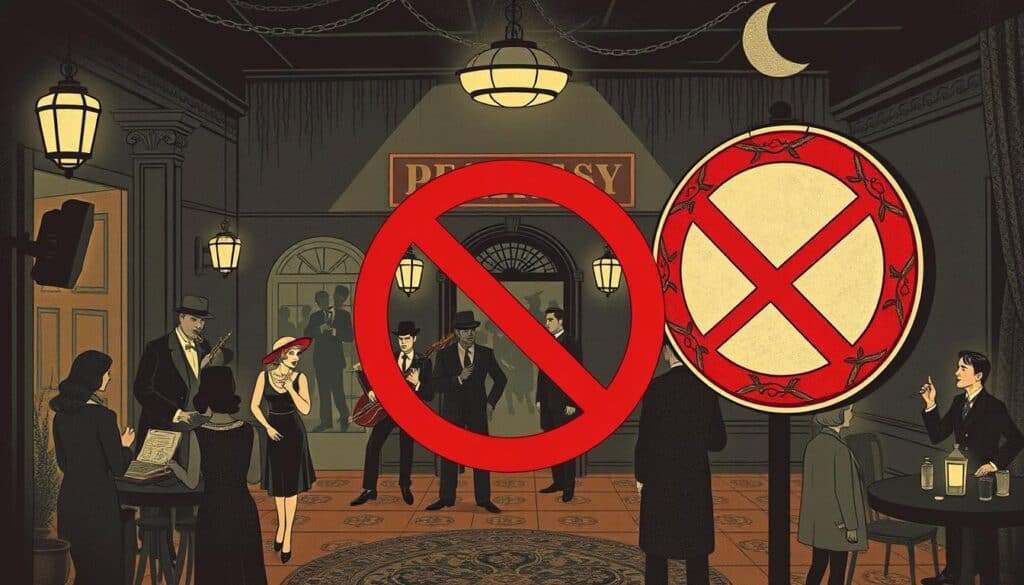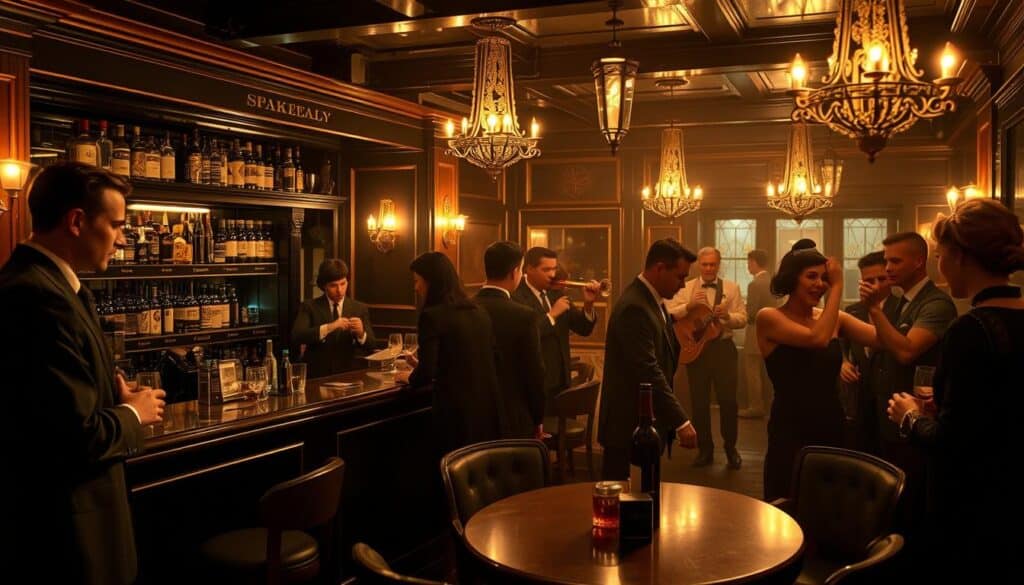The Volstead Act, a landmark legislation, defined the Prohibition era in the United States. This act banned the manufacture, sale, and transportation of intoxicating liquors, significantly impacting American society. The Prohibition era, which lasted for 14 years, was marked by a 30% drop in alcohol consumption and a 50% reduction in the consumption of hard liquor. The Volstead Act played a crucial role in shaping the Prohibition history of the United States.
The Prohibition era was a result of decades of advocacy by the temperance movement, which sought to reduce the consumption of alcohol in the United States. The movement led to the formation of the American Temperance Society in 1826 and the Anti-Saloon League in 1893. Between 1905 and 1917, states across the U.S. imposed laws prohibiting the manufacture and sale of intoxicating beverages, ultimately leading to the proposal of Prohibition as the 18th Amendment to the Constitution in 1917. The Volstead Act was a key component of this amendment, and its impact on American society was profound.
Key Takeaways
- The Volstead Act banned the manufacture, sale, and transportation of intoxicating liquors in the United States.
- The Prohibition era lasted for 14 years, resulting in a 30% drop in alcohol consumption.
- The consumption of hard liquor decreased by 50% during the Prohibition era.
- The Volstead Act played a significant role in shaping the Prohibition history of the United States.
- The act had a profound impact on American society, leading to the rise of organized crime and the proliferation of speakeasies.
- The Prohibition era was marked by a significant increase in law enforcement efforts and the expansion of the prison industry.
Introduction to The Volstead Act
The Volstead Act, introduced in the 66th United States Congress, marked the beginning of the Prohibition era in the United States. This significant piece of legislation had a profound impact on American society, leading to the rise of organized crime and the proliferation of Speakeasy bars. During this time, the production and sale of alcoholic beverages were strictly regulated, giving rise to a new era of Craft cocktails and underground drinking establishments.
The Prohibition era was marked by significant social and cultural changes, including the rise of gangsters and the growth of organized crime. The Volstead Act, which became effective on two separate dates, October 28, 1919, and January 17, 1920, allowed for the production of 200 gallons of “non-intoxicating cider and fruit juice” per year at home, but specified fines and jail sentences for the manufacture, sale, and movement of alcoholic beverages.
- The Volstead Act consisted of twelve thousand words and was in effect for thirteen years, from 1920 until its repeal in December 1933.
- Gangs took over the distribution of alcoholic beverages and fought violent confrontations for market control.
- Home winemaking was effectively legalized by the Act, with different regulations for wine and beer making.
| Year | Event |
|---|---|
| 1919 | War Prohibition Act went into effect in Minnesota |
| 1920 | Volstead Act became effective |
| 1933 | Volstead Act was repealed |
The Origins of Prohibition
The concept of Prohibition in the United States has a rich and complex history, dating back to the late 19th century. During this time, the temperance movement began to gain momentum, driven by a desire to reduce the consumption of alcohol in the country. This movement was characterized by a vintage ambiance of social reform, with many advocating for a complete ban on the manufacture, sale, and transportation of intoxicating liquors.
As the movement gained traction, it paved the way for the Roaring twenties, a decade marked by significant social change and cultural shifts. The passage of the 18th Amendment to the Constitution in 1919, which banned the manufacture, sale, and transportation of intoxicating liquors, was a major milestone in the Prohibition movement. This amendment was ratified by 36 states and went into effect in 1920, marking the beginning of a new era in American history.
Historical Context
The historical context of Prohibition is fascinating, with many key figures playing important roles in its passage. The Women’s Christian Temperance Union (WCTU) and the Anti-Saloon League were two prominent organizations that advocated for Prohibition, using various tactics to influence public opinion and shape policy. The WCTU, in particular, was instrumental in promoting women’s suffrage and temperance, with its members working tirelessly to educate the public about the dangers of alcohol.
Key Figures Involved
Several key figures were involved in the Prohibition movement, including Wayne Wheeler, a prominent leader of the Anti-Saloon League. Wheeler played a crucial role in drafting the Volstead Act, which provided guidelines for enforcing Prohibition. Other notable figures, such as Al Capone, became infamous for their involvement in organized crime during the Prohibition era, exploiting the ban on alcohol to amass vast fortunes.
Societal Influences Leading to Prohibition
Societal influences, such as the rise of urbanization and industrialization, contributed to the growing demand for Prohibition. Many Americans believed that alcohol was a major social problem, contributing to poverty, crime, and family breakdown. The Prohibition movement tapped into these concerns, using persuasive rhetoric and clever marketing to win over public support. As a result, the vintage ambiance of the Prohibition era was marked by a unique blend of social reform and cultural upheaval, setting the stage for the Roaring twenties and beyond.
The Legislative Process Behind The Volstead Act
The legislative process behind the Volstead Act was complex and involved several key legislators. The act was passed on October 28, 1919, and was the result of decades of advocacy by the temperance movement. Craft spirits enthusiasts were particularly affected by this legislation, as it prohibited the manufacture, sale, and transportation of intoxicating liquors.
The Prohibition history of the United States is marked by the Volstead Act, which faced significant challenges during its passage. The act was met with opposition from the liquor industry and concerns about the impact on the economy. Despite these challenges, the act was passed, and it had a profound impact on the country.
Key Legislators and Their Roles
Several key legislators played important roles in the passage of the Volstead Act. These legislators worked tirelessly to ensure that the act was passed, and their efforts ultimately led to the prohibition of intoxicating liquors in the United States.
Challenges Faced During Passage
The Volstead Act faced several challenges during its passage, including opposition from the liquor industry and concerns about the impact on the economy. Despite these challenges, the act was passed, and it had a profound impact on the country.
The Role of Public Opinion
Public opinion played a significant role in the passage of the Volstead Act. Many Americans supported the prohibition of intoxicating liquors, and their voices were heard by legislators. The act was ultimately passed, and it marked a significant shift in the country’s Prohibition history.
| Year | Event |
|---|---|
| 1919 | Volstead Act passed |
| 1933 | Prohibition repealed |
Understanding The Volstead Act
The Volstead Act, passed on October 28, 1919, was a comprehensive piece of legislation that defined the Prohibition era in the United States. To understand the act, it’s essential to delve into its definitions and key provisions. The act classified all beverages containing more than one-half of 1% alcohol by volume as alcoholic, which had a significant impact on the production and sale of intoxicating liquors.
The Prohibition era, marked by the Volstead Act, was characterized by strict regulations on the manufacture, sale, and transportation of intoxicating liquors. However, the act included several exemptions and exceptions, such as the production of medicinal whiskey. Distilleries like the Large Distillery in Allegheny County, Pennsylvania, and the Gwynnbrook Distillery in Baltimore County, Maryland, were granted permits to make medicinal whiskey, highlighting the complexities of the act.
Key Provisions and Exemptions
The Volstead Act had several key provisions, including fines and prison terms for violation of the law. The act also limited doctors to 100 alcohol prescriptions every 90 days, as refined by the Willis-Campbell Act in 1921. Some of the exemptions and exceptions included:
- Medicinal whiskey production
- Sacramental wine for religious purposes
- Industrial alcohol production

Understanding the Volstead Act and its provisions is crucial to grasping the complexities of the Prohibition era. The act’s impact on American society was significant, and its legacy continues to be felt today.
The Implementation of The Volstead Act
The Volstead Act, which officially implemented Prohibition in the United States on January 17, 1920, had a significant impact on the country. The law defined intoxicating liquors as beverages with more than 0.5% alcohol by volume, leading to the rise of Speakeasy bar culture and the creation of Craft cocktails to circumvent the law.
Enforcement of the Volstead Act proved challenging, leading to widespread disregard for the law. The federal government spent over $300 million to enforce Prohibition, but the efforts were largely unsuccessful. As a result, organized crime flourished, with bootleg liquor sales generating a revenue of $3.6 billion in 1926.
Enforcement Agencies Established
The Prohibition Bureau was established to enforce the Volstead Act, but it faced significant challenges. The bureau was understaffed and underfunded, making it difficult to effectively enforce the law. Despite these challenges, the bureau worked to disrupt the operations of organized crime groups involved in bootlegging.
Impact on Law Enforcement Tactics
The Volstead Act led to a significant shift in law enforcement tactics. Police officers had to adapt to a new era of Prohibition, using new strategies to enforce the law. However, the rise of organized crime and the widespread disregard for the law made it difficult for law enforcement to keep up. The Craft cocktails and Speakeasy bar culture continued to thrive, despite the efforts of law enforcement to shut them down.
The Public Reaction to The Volstead Act
The public reaction to the Volstead Act was significant, with many Americans opposing the act and its provisions. The act led to the emergence of grassroots movements and protests, which sought to repeal the act and restore the right to consume alcohol. During this time, the Vintage ambiance of the Roaring twenties was still present, but it was now associated with secrecy and rebellion.
Some of the key reactions to the Volstead Act include:
- Increased support for repeal of the 18th Amendment
- Growth of organized crime and bootlegging
- Emergence of speakeasies and underground bars
The Roaring twenties were marked by a sense of freedom and rebellion, and the Volstead Act was seen as a threat to this way of life. As a result, many Americans continued to drink and socialize in secret, creating a sense of Vintage ambiance that still exists today.
In conclusion, the public reaction to the Volstead Act was complex and multifaceted, reflecting the changing values and attitudes of American society during the Roaring twenties. The act’s provisions and enforcement had a significant impact on the country, leading to the growth of organized crime and the emergence of a vibrant, albeit underground, drinking culture.
| Year | Event | Impact |
|---|---|---|
| 1919 | Volstead Act implemented | Prohibition begins |
| 1920 | Speakeasies emerge | Underground drinking culture grows |
| 1933 | 21st Amendment ratified | Prohibition ends |
The Bootlegging Boom
The Prohibition era in the United States led to a significant rise in bootlegging, with many individuals turning to illegal alcohol production and distribution. This period, known as the bootlegging boom, saw the emergence of famous bootleggers who made vast fortunes from their illicit activities. The craft spirits industry, which had been thriving before Prohibition, was severely impacted, leading to a surge in underground production and distribution.
Some notable bootleggers, such as Al Capone and George Remus, earned millions of dollars from their operations. Capone’s syndicate, for example, ran around 6,000 speakeasies and made over $6 million a week in the 1930s. The Prohibition history of the United States is marked by the rise of organized crime, which played a significant role in the bootlegging boom. The Volstead Act, which enforced Prohibition, was unable to curb the demand for alcohol, leading to a proliferation of bootlegging operations.
The bootlegging boom had a profound impact on American society, with homicides, burglaries, and assaults increasing significantly between 1920 and 1933. The era also saw the emergence of moonshiners, who produced alcohol in illegal stills, often in rural areas. The Prohibition history of the United States is a complex and fascinating topic, with the bootlegging boom being a significant aspect of this period. The craft spirits industry, which had been severely impacted by Prohibition, would eventually recover, but the legacy of the bootlegging boom continues to be felt today.
Key facts about the bootlegging boom include:
- Over 1,000 people were killed in New York during Mob clashes in the Prohibition era.
- Al Capone paid out $500,000 per month to police to allow his illegal booze trade operations.
- George Remus, a bootlegger, earned an estimated $50 million from selling liquor supposedly for medicinal use during Prohibition.
The Cultural Shifts Caused by Prohibition
The Prohibition era, which lasted from 1920 to 1933, had a significant impact on American culture. The Volstead Act, which enforced Prohibition, led to the rise of speakeasies, also known as hidden bars. These secret establishments became a staple of urban nightlife, offering a place for people to socialize and enjoy music, dance, and drinks.
Some notable effects of Prohibition on culture include:
- The rise of the Jazz Age, with its vibrant music and dance
- The emergence of speakeasies, which became a symbol of rebellion against The Volstead Act
- Changes in social norms, with women becoming more accepted in public social settings
The Speakeasy bar scene was particularly influential, with famous establishments like Sherman Billingsley’s Stork Club in New York. These bars offered a unique experience, with live music, dancing, and a wide range of cocktails. The competition for patrons in speakeasies created a demand for live entertainment, leading to the popularization of jazz music and dances during the Roaring Twenties.

The cultural shifts caused by Prohibition were significant, and their impact can still be seen today. The legacy of The Volstead Act and the Speakeasy bar scene continues to influence American culture, with many modern bars and clubs drawing inspiration from this era.
| Year | Number of Speakeasies |
|---|---|
| 1920 | 1,000 |
| 1925 | 10,000 |
| 1930 | 32,000 |
The Economic Impact of Prohibition
The economic impact of Prohibition was significant, with many legitimate businesses suffering as a result of the act. The vintage ambiance of the Roaring twenties was marked by a flourishing black market, with bootlegging becoming a major economic activity. Approximately a quarter of a million people lost their jobs when Prohibition went into effect, and the federal government lost an estimated $11 billion in tax revenue during Prohibition.
The bootleg market earned $3.6 billion in 1926, equivalent to around $50 billion in today’s dollars. This had a profound impact on the economy, particularly during the Great Depression. The economic role of bootlegging was substantial, with some individuals profiting greatly from the illegal trade. For example, doctors profited around $40 million from medicinal whiskey prescriptions during Prohibition.
The effects on legitimate businesses were also significant, with many industries, such as the alcohol and hospitality industry, being severely impacted. However, this industry is currently valued at hundreds of billions of dollars, demonstrating the potential for economic growth and recovery. The Road to recovery was long, but the end of Prohibition marked a significant turning point in the economy.
| Year | Bootleg Market Earnings | Federal Tax Revenue Lost |
|---|---|---|
| 1926 | $3.6 billion | $11 billion |
| 1929 | $5 billion | $15 billion |
The End of Prohibition
The Prohibition era in the United States lasted for 13 years, from 1920 to 1933, and had a significant impact on the country’s Craft spirits industry. The 18th Amendment, which prohibited the manufacture, sale, and transportation of alcohol, was ratified in 1919 and took effect in 1920. However, the amendment was repealed in 1933 with the passage of the 21st Amendment, marking the end of Prohibition.
The factors leading to the repeal of Prohibition were complex and multifaceted. The Great Depression, which began in 1929, had a devastating impact on the economy, and the loss of tax revenue from alcohol sales was a significant contributor to the federal government’s financial woes. Additionally, the rise of organized crime and the proliferation of speakeasies and bootlegging operations had made Prohibition increasingly unpopular.

The 21st Amendment, which repealed the 18th Amendment, was ratified on December 5, 1933. This marked the end of Prohibition and allowed states to regulate the sale and consumption of alcohol. The repeal of Prohibition had a significant impact on the Craft spirits industry, as it allowed distilleries and breweries to operate legally once again.
| Year | Event |
|---|---|
| 1919 | 18th Amendment ratified |
| 1920 | Prohibition takes effect |
| 1933 | 21st Amendment ratified, repealing Prohibition |
The end of Prohibition marked a significant shift in the country’s Prohibition history, and had a lasting impact on the Craft spirits industry. Today, the United States is home to a thriving craft distilling and brewing industry, with many small, independent producers creating unique and innovative products.
The Legacy of The Volstead Act Today
The Volstead Act, which marked the beginning of the Prohibition era, has left a lasting impact on American society. Today, many Americans continue to debate the merits of Prohibition and its effects on the country. The act serves as a valuable lesson in considering the unintended consequences of legislation and the need for ongoing conversation about alcohol regulation.
Some notable facts about the Prohibition era include:
- Only 26 states allowed the sale of medicinal liquor in the first five years of Prohibition.
- Canadian export houses had their annual licensing fees raised from $3,000 to $10,000 to stem the flow of liquor to the United States.
- The U.S. federal government adopted a three-tier alcohol distribution system after the repeal of Prohibition to regulate sales and collect tax revenue.
The legacy of The Volstead Act can be seen in the modern craft spirits industry, with companies like Buffalo Trace launching limited-edition collections honoring Prohibition-era whiskeys. Additionally, organizations like the American Crafts Spirits Association (ACSA) continue to advocate for loosened regulations for craft spirits.
In conclusion, The Volstead Act and the Prohibition era have had a lasting impact on American society, with many lessons learned from history. The ongoing conversation about alcohol regulation continues, with a focus on finding a balance between responsible drinking and economic growth.
| Year | Event | Impact |
|---|---|---|
| 1930 | Canadian government passes law banning foreign customers from purchasing booze directly from export houses | Liquor smuggling from Canada continues |
| 1933 | Repeal of Prohibition | End of Prohibition era, adoption of three-tier alcohol distribution system |
Conclusion
In conclusion, the Volstead Act’s legacy continues to shape discussions around alcohol regulation in the United States. While the era of Prohibition was marked by the rise of speakeasy bars and the proliferation of craft cocktails, it also had significant unintended consequences, including the growth of organized crime and a decline in public trust in law enforcement.
Although alcohol consumption dropped by 30% during Prohibition, the act ultimately failed to achieve its goal of eliminating the use of intoxicating liquors. The illegal alcohol trade thrived, and some Americans even resorted to making their own alcohol at home. The economic impact was also substantial, with the closure of thousands of jobs in related industries and a decline in tax revenue for the government.
Today, the lessons learned from the Volstead Act continue to shape policies around alcohol regulation. As the debate over the merits and drawbacks of Prohibition remains ongoing, it is clear that the act’s influence has had a lasting impact on American society.
